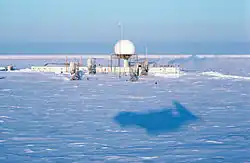AN/FPS-19
 The FPS-19's radome dominates this image of the POW-2 DEW station. | |
| Country of origin | US |
|---|---|
| Manufacturer | Raytheon |
| Introduced | 1953 |
| No. built | ~35 |
| Type | early warning |
| Frequency | L-band, 1220 to 1350 MHz |
| PRF | 400 pps |
| Pulsewidth | 6 μs |
| Range | 160 mi (260 km) |
| Diameter | 75 ft (23 m) |
| Azimuth | 360º |
| Power | 500 kW x 2 |
The AN/FPS-19 was a long-range search radar developed for the NORAD Distant Early Warning Line (DEW Line) by Raytheon. It was an L-band system working between 1220 and 1350 MHz produced by a 500 kW magnetron. Two such systems were placed back-to-back, one with an antenna that produced a narrow beam to improve range for long-range detection, and the second with a wider fan-shaped beam to cover higher angles at shorter ranges. The former could detect bomber-sized targets to about 160 miles (260 km) and the latter covered up to 65,000 ft (20,000 m) altitude.
The system was developed from the AN/TPS-1, which dated to the late World War II era. Raytheon adapted it to the long-range role by designing much larger antenna systems and other modifications. The first examples were activated in 1957, along with the AN/FPS-23 radars that provided low-altitude coverage between the stations. The AN/FPS-23 was removed in 1963, and the FPS-19 was scheduled to be replaced by the somewhat more powerful AN/FPS-30. The declining role of bomber defense in the era of the intercontinental ballistic missile (ICBM) meant these upgrades were not carried out. The FPS-19 remained in service until the late 1980s when they were replaced by the AN/FPS-117 as part of the newly named North Warning System.
The UK equivalent was the AMES Type 80, a significantly more powerful radar that formed the basis of their post-ROTOR network.
In accordance with the Joint Electronics Type Designation System (JETDS), the "AN/FPS-18" designation represents the 18th design of an Army-Navy electronic device for fixed ground search radar.[1][2]
See also
References
![]() This article incorporates public domain material from the Air Force Historical Research Agency
This article incorporates public domain material from the Air Force Historical Research Agency
- ^ Winkler, David F. (1997). "Radar Systems Classification Methods". Searching the Skies: The Legacy of the United States Cold War Defense Radar Program (PDF). Langley AFB, Virginia: United States Air Force Headquarters Air Combat Command. p. 73. LCCN 97020912.
 This article incorporates text from this source, which is in the public domain.
This article incorporates text from this source, which is in the public domain.
- ^ Avionics Department (2013). "Missile and Electronic Equipment Designations". Electronic Warfare and Radar Systems Engineering Handbook (PDF) (4 ed.). Point Mugu, California: Naval Air Warfare Center Weapons Division. pp. 2–8.1.